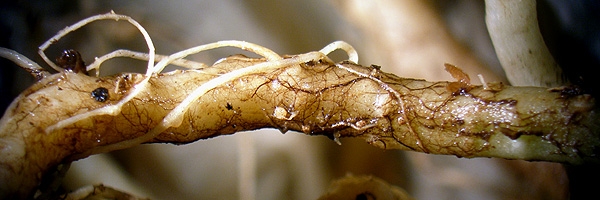
Thanatephorus cucumeris (A.B. Frank) Donk (1956)
- Classification: Fungi, Basidiomycota, Cryptomycocolacomycetes, Incertae_sedis_, Cantharellales, Ceratobasidiaceae
- synonymie : Rhizoctonia solani J.G. Kühn (1858)
- English names: damping-off, fruit rot
T. cucumeris (syn. R. solani ) is worldwide widespread and reported in many production areas of Cucurbitaceae, and melon. It is capable of infecting several hundred different hosts and several Cucurbits: watermelon, cucumber, melon, zucchini and squash, christophine, bitter gourd ( Momordica charantia ), wax squash ( Benincasa hispida ) ...
On melon, this telluric * fungus is especially known to cause damping-off in nurseries, root and crown lesions, and damage to the stem and to the fruits. This is particularly the case in France where it is frequently associated with this plant.
It should be noted that it is considered to be a biological marker for “tired” market garden soils which have repeatedly borne Cucurbitaceae and / or other sensitive vegetable crops.
Much work has been done on this fungus in ubiquitous and polyphagous order to characterize the diversity of its strains. Indeed, these differ among other things by their cultural characteristics, their pathogenicity and in particular their host specificity. Among the differentiation criteria studied, their anastomosis affinities have made it possible to establish more than ten groups (GA), and sometimes even subgroups. The knowledge at our disposal on strains rife on melon is still limited. By way of example, strains belonging to the AG-4 group have been mentioned on several occasions on melon.
- synonymie : Rhizoctonia solani J.G. Kühn (1858)
- English names: damping-off, fruit rot
T. cucumeris (syn. R. solani ) is worldwide widespread and reported in many production areas of Cucurbitaceae, and melon. It is capable of infecting several hundred different hosts and several Cucurbits: watermelon, cucumber, melon, zucchini and squash, christophine, bitter gourd ( Momordica charantia ), wax squash ( Benincasa hispida ) ...
On melon, this telluric * fungus is especially known to cause damping-off in nurseries, root and crown lesions, and damage to the stem and to the fruits. This is particularly the case in France where it is frequently associated with this plant.
It should be noted that it is considered to be a biological marker for “tired” market garden soils which have repeatedly borne Cucurbitaceae and / or other sensitive vegetable crops.
Much work has been done on this fungus in ubiquitous and polyphagous order to characterize the diversity of its strains. Indeed, these differ among other things by their cultural characteristics, their pathogenicity and in particular their host specificity. Among the differentiation criteria studied, their anastomosis affinities have made it possible to establish more than ten groups (GA), and sometimes even subgroups. The knowledge at our disposal on strains rife on melon is still limited. By way of example, strains belonging to the AG-4 group have been mentioned on several occasions on melon.
* It should be noted that several fungi, alone or in complexes (this varying according to the production zones and the plots), have been associated in the world (Japan, Israel, Spain, Italy, USA ) with wilting and collapse of melon plants (vine decline, vine collapse), accompanied by lesions and root rots. Among the most common are: Acremonium cucurbitacearum (Syn. Nodulisporium melonis , now called Plectosphaerella melonis ), Macrophomina phaseolina , Monosporascus connonballus , Pyrenochaeta lycopersici , Pythium spp., Rhizoctonia solani , Rhizopycnis ...





